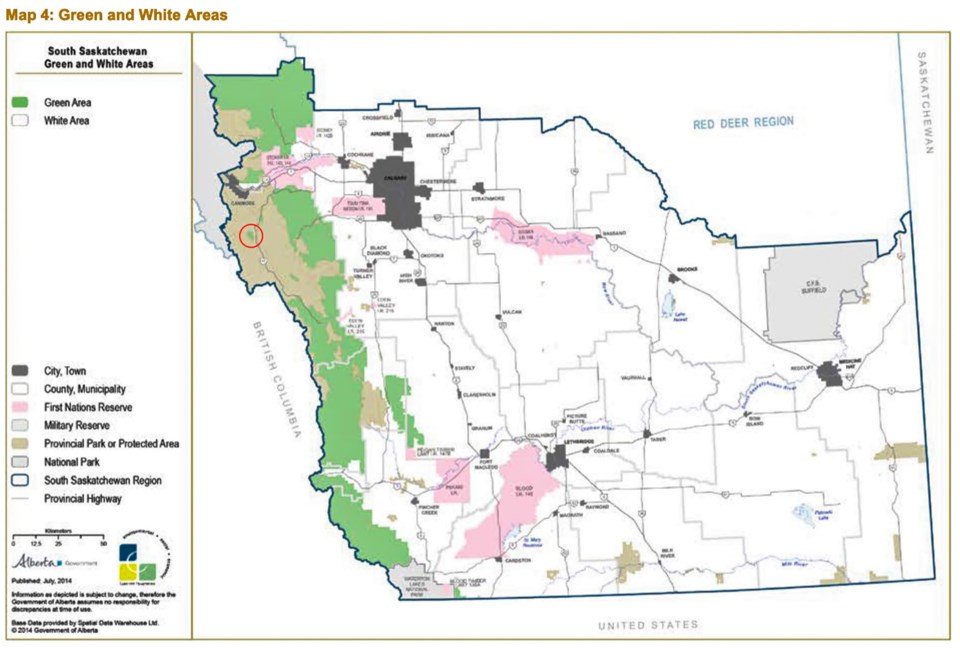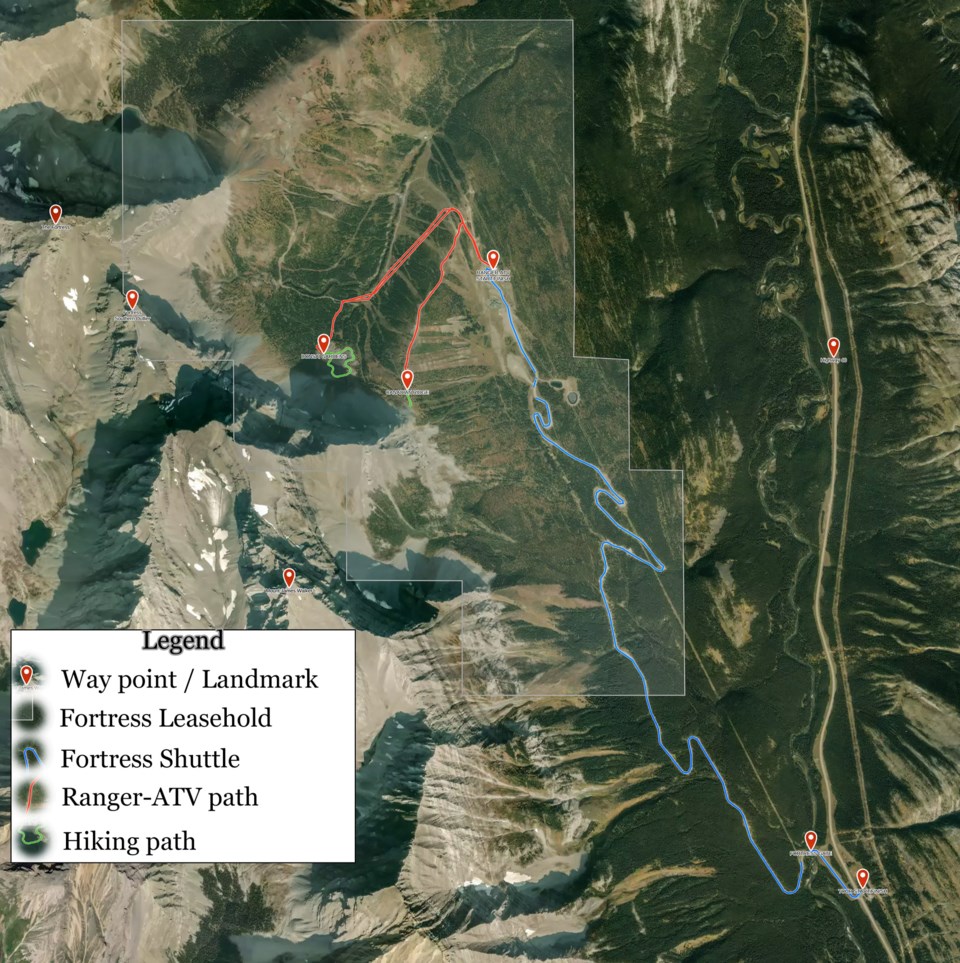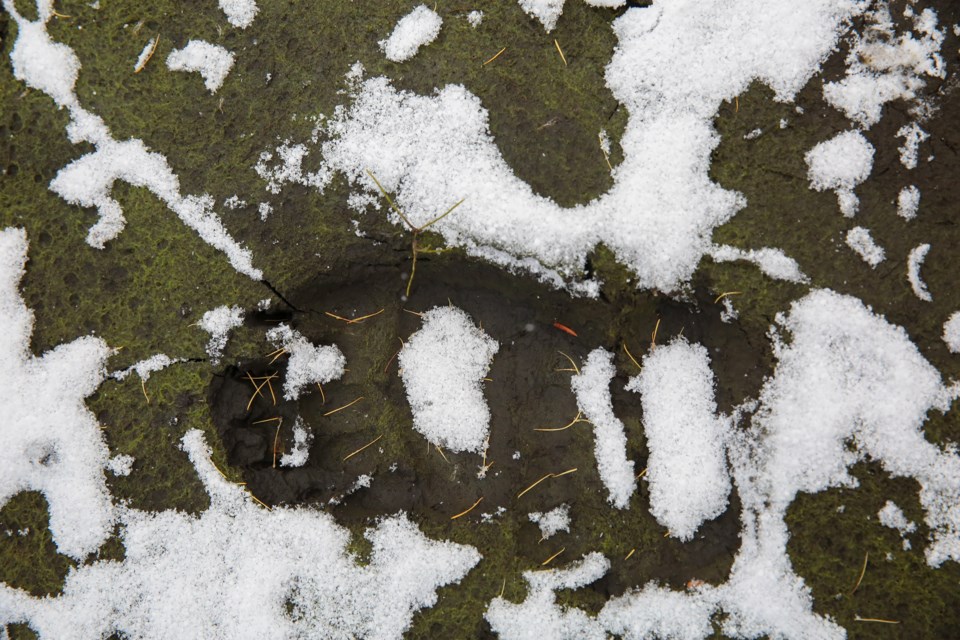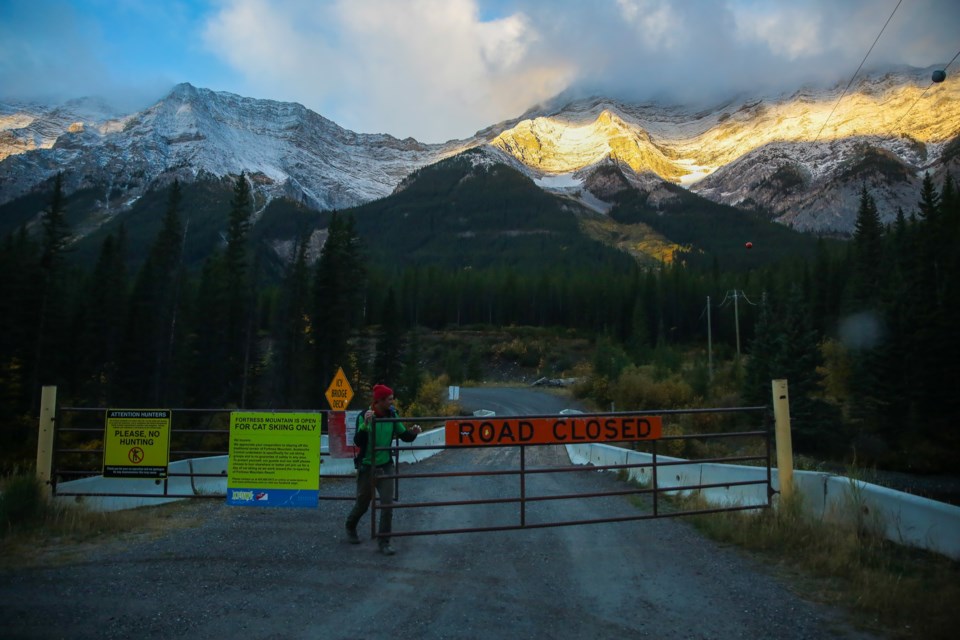KANANASKIS – A mixture of mud and snow spins off the tires of the Ranger-ATV as it climbs up Canadian Ridge at Fortress Mountain Resort.
It’s late September. There is a bite to the air as the off-highway-vehicle (OHV), operated by a guide from White Mountain Adventures (WMA), surpasses 2,100nmetres in elevation.
“We are getting close to 2,200 metres, I hope you guys have your long johns on,” said guide Sam Campeau to the tour group over the rumble of the engine.
The OHV comes to a stop underneath the towering cliffs of The Fortress and in-between the long-forgotten Canadian Triple Chair and Backside Double Chair lift stations that last ferried skiers around the ski resort in 2004. The tour group disembarks the OHV and walks along the ridge, taking in the impressive views of the snow-capped peaks of Kananaskis Country.
“Down there is where we are going next, Bonsai Gardens,” said Campeau, pointing to the dried out lake bed on the backside of Canadian Ridge. “You can see all the golden larches; that’s why we’re here.”
Soon after stepping out of the OHV and walking in the Bonsai Gardens, evidence of wildlife was easy to spot. Grizzly bear and moose tracks wear clearly visible in the dried-up lake bed.
“This is where we saw a mama grizzly and her cubs just a couple of days ago,” said Campeau as he pointed out the grizzly paw print stamped into the mud.
The Fortress larches and Fortress ridgeline tours are Ranger-ATV-assisted tours designed to allow visitors easy access to the Alberta backcountry, which began operations at Fortress Mountain Resort in mid-August.
On July 23, 2020, Alberta Environment and Parks (AEP) issued a Temporary Field Authorization (TFA) to Fortress Mountain Holdings Ltd. (FMH) for guided hiking, guided fishing and guided photo sessions within their leasehold in response to COVID-19 business impacts.
A TFA is a non-renewable stand-alone authorization issued for short-term activities on vacant public land and vary depending on the purpose and activity being applied for. Applications for TFAs can range from education/research activities, geotechnical operations, or commercial activities, which is how Fortress applied for the TFA to operate the tours.
“As the province began to see an easing of those first wave of restrictions, we wanted to have a look at what we could do to get, not only our staff but other area staff, back to work in a safe way,” said Chris Mueller, director of operations at Fortress Mountain Resort, in an email.
“Knowing that the outdoors would be a highly desired escape for many, as we saw with the crowds in Kananaskis Country over the summer, we approached the Alberta government to look at operating some guided hiking tours with an area partner that we have worked with many times in the past – White Mountain Adventures.”
The partnership between WMA and Fortress goes back seven years. In 2013, in response to business impacts sustained by the devastating flooding that affected much of the Bow Valley and Kananaskis, AEP granted a TFA to Fortress to operate guided hiking tours throughout the summer and fall season, without the use of an OHV.
“At that time because of the flood, similar to now, I think the government was looking at ways to keep people busy and keep businesses afloat,” said Gordon Stermann, president of WMA. “They [Fortress] came to us, I think because of the relationship I had had with Chris Mueller and Chris Chevalier from our time operating tours at Sunshine.”
Fortress’s lease agreement, which was renewed in July this year until 2045, stipulates it may only use the lands for a winter alpine and ski resort facility and does not allow for summer use. However, through the authorizations of TFAs, Fortress has been able to operate as a popular film location for movies, TV and commercials in the summer months over the past seven years as outlined in semi-annual progress reports it is required to send to AEP.
The temporary permit in 2013 and this year allowed Fortress to run summer operations for tours. The duration of a TFA is determined by the applicant based on its estimated start date and completion date.
“They approached us to operate these tours … to drive people up and hike with them. We thought the best thing for us to do was to offer a really cool product. It’s more exclusive and it’s different. Within two weeks we had something up and running,” Stermann said.
For Stermann, the guided tours provided the only bright spot business-wise in what he called a “dismal year.”
“We were very appreciative that the government recognized the struggles that both the Alberta public and Alberta businesses were going through and that they were open to accommodating the proposal," Mueller said. "These tours provided a much sought-after escape for the many Albertans that joined us over the summer.”
Fortress is permitted to use off-highway vehicles to conduct operations within its leasehold, because of its “green area” status as outlined in the South Saskatchewan Regional Plan, and the lease agreement, and is held to strict regulations for OHV use.
 A map from the South Saskatchewan Regional Plan highlighting "green areas," with Fortess circled in red. Fortress is permitted to use on and off-highway vehicles to conduct their operations within their dispositions, because of its “green area” status as outlined in the South Saskatchewan Regional Plan. EVAN BUHLER RMO ILLUSTRAION
A map from the South Saskatchewan Regional Plan highlighting "green areas," with Fortess circled in red. Fortress is permitted to use on and off-highway vehicles to conduct their operations within their dispositions, because of its “green area” status as outlined in the South Saskatchewan Regional Plan. EVAN BUHLER RMO ILLUSTRAION“The use of side-by-sides, trucks, vans, quads, aerial lifts is commonplace in the mountain resort industry to move people, both public and employees around in the summer. For us, we use these tools to move our work crews around the area on our established mountain roads along with supporting the hiking tours,” said Mueller.
“These are transport and work vehicles only; they are not being used as ‘off-road’ machines. We solely utilize designated winter travel routes and established summer on-mountain roads; there is no ‘off-roading’ on untouched, undesignated routes. All of our staff are trained to this system, we operate to industry standard and under what is permitted through our dispositions.”
Fortress decided to use the side-by-side OHVs due to their low impact and limited carrying capacity. The maximum occupancy is six – a guide/driver and five passengers.
“These vehicles are used for transport and transport only," said Mueller. "They are work vehicles, not recreational toys. We have the highest level of constraint on their use and the manner and conditions in which they are used."
Evolution of ski resorts
Looking around at the mountain resort industry both in Western Canada and throughout the world, summer operations have become commonplace. Areas like Whistler, Silver Star, Fernie, and locally at Lake Louise, Sunshine and Norquay – all offer summer recreational activities.
“It is important to keep in mind that resorts are businesses just like any other, and just like any other business, they are always looking for ways to evolve, innovate, and accommodate what their market is looking for,” said Mueller.
While climate change is one factor in ski resorts' push to become year-round attractions, Mueller believes the economics of operating an alpine resort forces them to spend an incredible amount of money to compete within the industry.
“Without summer operations, resorts sit idle for five or six months of the year. This makes it difficult to justify the significant expense,” he said.
Over the past few years, Fortress has unsuccessfully attempted to include summer operations in its lease agreement.
Another factor, and probably the biggest one driving the industry, said Mueller, is the increase in demand for summer experiences by the public.
“This includes hiking, Via Ferrata, mountain biking, zip-lining, weddings, retreats, alpine spas – the list goes on," he said. "People are looking for things to do in an environment that reconnects them with nature.”
Even before the pandemic, Kananaskis and Banff’s combined visitation numbers were about 7.5 million visitors per year. This year, Kananaskis was bursting at the seams, with domestic visitors flocking to the mountains to escape the COVID-19 lockdown.
A gate restricts vehicle access to the leasehold, making Fortress one of the areas with the lowest visitation numbers in Kananaskis Country.
“It is an area that has seen very few people over the years. We are not taking busloads, we’re taking people in very small controlled groups into this environment,” said Stermann. “The goal has to be how do you control the large number of people on trails, and I hope we are part of the answer.”
 Paths outlining the Ranger-ATV assisted tours run this past fall at Fortress. EVAN BUHLER MAP ILLUSTRATION
Paths outlining the Ranger-ATV assisted tours run this past fall at Fortress. EVAN BUHLER MAP ILLUSTRATIONConcern about the environmental impact of tours
Almost as soon as the operation of tours started, environmentalists following Fortress took notice, due to the unique location of the Fortress leasehold within Kananaskis.
Kananaskis Country is 4,000-square kilometres of wildlands and includes nine provincial parks and over 50 recreation, wilderness and natural areas that are part of Alberta’s parks and protected area.
“Fortress is in a unique situation because it was grandfathered into the landscape when the Kananaskis protected area complex was created. The Fortress leasehold is really like the hole in a doughnut of the protected areas," said Sarah Elmeligi, an independent consultant with Canadian Parks and Wilderness Society (CPAWS).
“What happens on the Fortress leasehold has a direct impact on the effectiveness of those protected areas to protect and conserve the ecological attributes of the landscape.”
Mueller said environmental sensitivity is a top priority at Fortress Mountain and the company routinely conducts wildlife "sweeps" of the area to observe if there are any wildlife present and if so, where they are and what they are doing.
A 2018 Golder and Associates study, conducted over a five-month period, documented confirmed sightings of grizzly bear, black bear, grey wolves, coyote, lynx, cougar, marten, mountain goats, bighorn sheep, deer, elk, moose, many other smaller animals, 21 bird species and four bat species within the Fortress leasehold.
When Fortress applied for a water hauling permit in 2019, concern was raised by Brett Boukall, an AEP biologist, about the disturbance to wildlife in the area.
In addition to Boukall’s concerns, an email, dated Aug, 19, 2019, from Geoff Smith, a land management specialist at AEP, to Mueller stated, “As has been identified within the grizzly bear recovery plan, the area in and around Fortress Mountain is considered critical grizzly bear habitat.”
Neil Warren, a Fortress whistleblower and environmentalist, opposes the Ranger-ATV assisted tours for this reason.
“I feel it is hypocritical to allow these tours when AEP referred to the Fortress area as ‘critical grizzly bear habitat,’ ” Warren said in a phone interview.
“It’s setting a precedent. In our society, we make decisions based on past decisions. If this becomes the new standard it sets a new precedent.”
 Grizzly bear tracks in the mud at Banzai Lake at Fortress Mountain on Saturday (Sept. 26). The lake drain every fall. EVAN BUHLER RMO PHOTO
Grizzly bear tracks in the mud at Banzai Lake at Fortress Mountain on Saturday (Sept. 26). The lake drain every fall. EVAN BUHLER RMO PHOTOElmeligi shares Warren’s concern.
“It’s a slippery slope. As soon as one company starts doing OHV tours on the eastern slopes of Kananaskis, what stops other companies from proposing something similar when they fall outside of provincial parks?”
“The motivation of increasing profit margins is fine, but there needs to be broader recognition that Fortress is in the middle of a really important protected area in Alberta and sensitive habitat for several species of wildlife.”
The 2016 Nakoda Grizzly Study, carried out by members of the Stoney Nakoda First Nation and AEP, backed up the concerns of Boukall and Smith at AEP concerning grizzly bears.
The study found that motorized access, concerning highway access, affected grizzly bears’ habitat use, home range selection, movements, population fragmentation, survival, and reproductive rates, which ultimately reflected in population density, trend and conservation status.
As a result, this increased human-caused mortality, habitat displacement, fragmentation, and direct habitat loss.
“ATV use is generally not considered a problem for bear habitat; however, for any type of recreation in bear country, there is the possibility of a bear-human interaction,” said John Muir director of communications for AEP in an emailed statement.
Elmeligi said motorized use in the middle of sensitive grizzly bear habitat is concerning, adding she was “shocked” to learn about the tours.
"There is research that demonstrates motorized recreational trails are problematic for grizzly and black bear habitat use and movement," she said.
She also said that ski hills in the summer make for good habitat for bears because of the open landscape and foraging options available. Because of this fact, she believes OHV use within Fortress could impact bears at a disproportionately higher rate than other parts of Kananaskis.
However, WMA’s Stermann believes the tours may have a more positive indirect effect on the preservation of the landscape and wildlife in the area.
“This program gets people into an area that has spectacular scenery," he said. "It gets people who normally wouldn’t have the ability to get into the backcountry out there. We want to get people into our spectacular nature. The more people get out into nature, the more they appreciate it, the more they support it, the more they protect it.”
The tours stopped operations at the end of September, hosting a total of 76 guests. Mueller said they received an incredible amount of positive feedback about the tours and are looking to operate a program similar to the ones operated this fall, after submitting a new TFA.
“We feel, with tourism at the forefront of economic diversification and recovery in Alberta, that we can really contribute in a positive and impactful way,” said Mueller.
“The professionalism and experience that White Mountain Adventure brings to the program really compliments our priorities of operating at the highest level of environmental responsibility.”
Elmeligi disagrees strongly with the use of OHV use on the tours, but does not see an issue with guided hikes, and suggesting other alternatives to motorized assistance for recreational purposes.
"Hiking is already happening on the surrounding landscape. If they want to offer guided hikes without an ATV and make some money off it – then that's in alignment with what's happening on the surrounding landscape. Involving motorized assistance is not in alignment with what is happening in the area so it compromises the conservation objective of Kananaskis," said Elmeligi.




